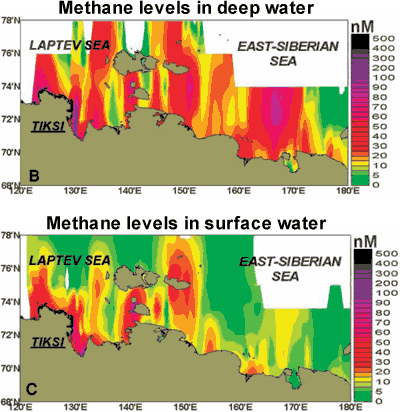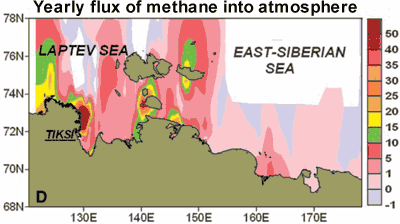
Figure 1: Summertime observations of methane levels in the ESAS. Top is dissolved methane in deep water. Bottom is dissolved methane in surface water (Shakhova 2010).
One of the positive feedbacks from global warming is the thawing of Arctic permafrost. This releases methane, a greenhouse gas over 20 times more potent than carbon dioxide, into the atmosphere. Investigations into Arctic methane have tended to focus on land permafrost. However, there are also vast amounts of methane held underwater in the East Siberian Arctic Shelf (ESAS). This encompasses over 2 million square kilometres, three times as large as the nearby Siberian wetlands, which have been considered the primary Northern Hemisphere source of atmospheric methane. Underwater permafrost acts as a lid to restrain methane stored in the seabed. Until now, it was thought the permafrost was cold enough to remain frozen. However, recent observations have found that over 80% of the deep water over the ESAS is supersaturated, with methane levels more than eight times that of normal seawater (Shakhova 2010). More than half of the surface water is supersaturated also. The methane venting into the atmosphere from this one region is comparable to the amount of methane coming out of the entire world’s oceans.
To find out what was happening in the East Siberian Arctic Shelf, field measurements, ice expeditions and a helicopter survey were conducted to measure methane levels in ESAS waters. They took 5100 samples from 1080 stations, the largest database for any ocean methane study. They found widespread supersaturation over the region. Most of the bottom waters are supersaturated and over half of surface waters are supersaturated. In some areas, the saturation levels reached at least 250 times that of background levels in the summer and 1,400 times higher in the winter.

Figure 1: Summertime observations of methane levels in the ESAS. Top is dissolved methane in deep water. Bottom is dissolved methane in surface water (Shakhova 2010).
To find out how much methane is escaping into the atmosphere, they measured the flux of methane at the ocean surface. Methane levels were elevated overall and the seascape was dotted with more than 100 hotspots. A helicopter survey further confirmed this, finding methane levels were 5 to 10% greater at 1800 metres height. Methane is not only being dissolved in the water, it's bubbling out into the atmosphere.

Figure 2: Yearly flux of methane venting into the atmosphere over the ESAS (Shakhova 2010).
These findings tell us the large underwater permafrost "lid" over the East Siberian Arctic Shelf is clearly perforated and methane is escaping to the atmosphere. Why is this a concern? The impact of positive feedback from ESAS methane is not currently included in climate model projections. However, we can deduce the role of methane feedback by looking at past climate change. About 11,600 years ago, the planet warmed very suddenly. This corresponded with strong increases in atmospheric greenhouse gases, especially Arctic methane (Petrenko 2009, Nisbet 2009). This indicates that the permafrost is sensitive to warming temperatures, having released it's methane in the past. This gives us much reason to be concerned about the trajectory of the vast methane stores leaking from the East Siberian Arctic Shelf.
Update 7 Mar 2010: Real Climate offer some good perspective on methane feedback which echoes the theme in CO2 is not the only driver of climate:
"CO2 is plenty to be frightened of, while methane is frosting on the cake. Imagine you are in a Toyota on the highway at 70 miles per hour approaching stopped traffic, and you find that the brake pedal is broken. This is CO2. Then you figure out that the accelerator has also jammed, so that by the time you hit the truck in front of you, you will be going 80 miles per hour instead of 70. This is methane. Is now the time to get worried? No, you should already have been worried by the broken brake pedal. Methane sells newspapers, but it’s not the big story, nor does it look to be a game changer to the big story, which is CO2."
Update 12 Mar 2010: Thanks to Charles Brock who alerted me to a paper published mid-2009, Observational constraints on recent increases in the atmospheric CH4 burden (Dlugokencky 2009). Key results (noting that this is based on data ending in 2008):
Measurements of atmospheric CH4 show that, after a decade of near-zero growth, globally averaged atmospheric methane increased during 2007 and 2008... Near-zero CH4 growth in the Arctic during 2008 suggests we have not yet activated strong climate feedbacks from permafrost and CH4 hydrates.
Posted by John Cook on Saturday, 6 March, 2010
 |
The Skeptical Science website by Skeptical Science is licensed under a Creative Commons Attribution 3.0 Unported License. |